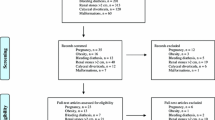Abstract
There are various recent studies on the use of ureteroscopy and debate on whether this should be the first-line treatment for patients with ureteral stones. The aim of this meta-analysis was to understand the role of this surgical procedure in the emergency setting as first-line treatment and to compare the immediate procedure with a delayed one in terms of stone-free rate and complications. A bibliographic search covering the period from January 1980 to March 2010 was conducted in PubMed, MEDLINE and EMBASE. This analysis is based on the six studies found that fulfilled the predefined inclusion criteria. A total of 681 participants were included. The number of participants in each of the studies considered ranged from 27 to 244 (mean 113). Stone-free rates were 81.9% (72.0–91.8) for the proximal ureter, 87.3% (82.6–92.0) for the mid-ureter, 94.9% (92.1–97.6) for the distal ureter and 89.5% (86.5–92.5) overall according to the logistic regression applied. These values are not statistically significantly different from those reported in the AUA and EAU guidelines. The stone diameter seems to affect the stone-free rate. An increase of the stone diameter of 1 mm beyond 8 mm corresponded to a reduction of stone-free rate of 5% (2.4–8.0) and 8.1% (3.8–12.1) for the distal and proximal ureters, respectively. There is a complete lack of information in international guidelines on the ureteroscopic management of ureteral stones in an emergency setting and the currently available results are dispersed in a few studies in the literature. The rationale for using emergency ureteroscopy is more rapid stone clearance and relief from colic pain. According to our meta-analysis, immediate ureteroscopy for ureteral stone colic seems to be a safe treatment with a high success rate. This evidence will be validated by further randomized studies, with larger series of patients.


Similar content being viewed by others
References
Hollingsworth JM, Rogers MA, Kaufman SR et al (2006) Medical therapy to facilitate urinary stone passage: a meta-analysis. Lancet 368:1171–1179
Liu M, Henderson SO (2007) Myth: nephrolithiasis and medical expulsive therapy. CJEM 9:463–465
EAU guidelines on urolithiasis 2011. http://www.uroweb.org/gls/pdf/18_Urolithiasis.pdf
Osorio L, Lima E, Autorino R et al (2008) Emergency management of ureteral stones: recent advances. Indian J Urol 24:461–466
Osorio L, Lima E, Soares J et al (2007) Emergency ureteroscopic management of ureteral stones: why not? Urology 69:27–31
Jiang H, Wu Z, Ding Q (2008) Ureteroscopy and holmium: YAG laser lithotripsy as emergency treatment for acute renal failure caused by impacted ureteral calculi. Urology 72:504–507
Yang S, Qian H, Song C et al (2010) Emergency ureteroscopic treatment for upper urinary tract calculi obstruction associated with acute renal failure: feasible or not? J Endourol 24:1721–1724
Al-Ghazo MA, Ghalayini IF, Al-Azab RS et al (2011) Emergency ureteroscopic lithotripsy in acute renal colic caused by ureteral calculi: a retrospective study. Urol Res 39:497–501
Sarica K, Tanriverdi O, Aydin M et al (2011) Emergency ureteroscopic removal of ureteral calculi after first colic attack: is there any advantage? Urology 78:516–520
Guercio S, Ambu A, Mangione F et al (2011) Randomized prospective trial comparing immediate versus delayed ureteroscopy for patients with ureteral calculi and normal renal function who present to the emergency department. J Endourol 25:1137–1141
Lindsey JK (1999) On the use of corrections for overdispersion. Appl Stat 48:553–561
DerSimonian R, Laird N (1986) Meta-analysis in clinical trials. Control Clin Trials 7:177–188
Harbord RM, Egger M, Sterne JA (2006) A modified test for small-study effects in meta-analyses of controlled trials with binary endpoints. Stat Med 25:3443–3457
Preminger GM, Tiselius HG, Assimos DG, EAU/AUA Nephrolithiasis Guideline Panel. et al (2007) 2007 guideline for the management of ureteral calculi. J Urol 178:2418–2434
Picozzi SC, Marenghi C, Casellato S et al (2011) Management of ureteral calculi and medical expulsive therapy in emergency departments. J Emerg Trauma Shock 4:70–76
Author information
Authors and Affiliations
Corresponding author
Rights and permissions
About this article
Cite this article
Picozzi, S.C.M., Ricci, C., Gaeta, M. et al. Urgent ureteroscopy as first-line treatment for ureteral stones: a meta-analysis of 681 patients. Urol Res 40, 581–586 (2012). https://doi.org/10.1007/s00240-012-0469-z
Received:
Accepted:
Published:
Issue Date:
DOI: https://doi.org/10.1007/s00240-012-0469-z




